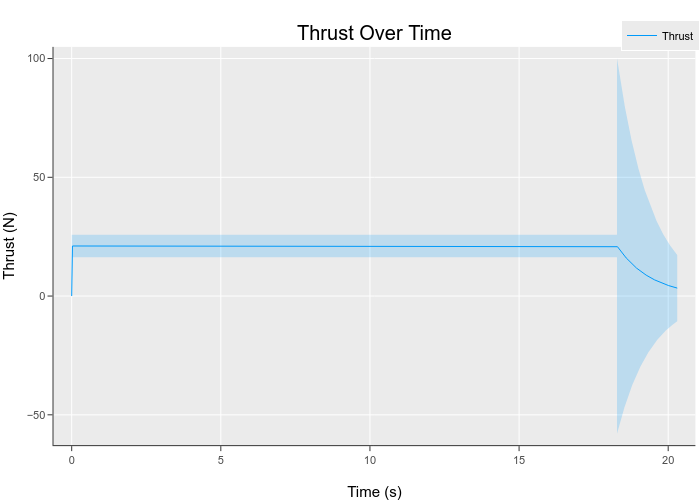Boilerplate intro about why all of this was done
Show code
using Plots
plotly()
theme(:ggplot2); # In true R spirit
using Unitful
using DataFrames
using Measurements
using Measurements: value, uncertaintyThis code is just the setup, using values scraped from various parts of the world wide web.
# Tank https://www.amazon.com/Empire-Paintball-BASICS-Pressure-Compressed/dp/B07B6M48SR/
V = (85 ± 5)u"inch^3"
P0 = (4200.0 ± 300)u"psi"
Wtank = (2.3 ± 0.2)u"lb"
Pmax = (250 ± 50)u"psi" # Max Pressure that can come out the nozzle
Wsolenoid = 1.5u"kg"
# Params
d_nozzle = ((1 // 18) ± 0.001)u"inch"
a_nozzle = (pi / 4) * d_nozzle^2
# Universal Stuff
P_amb = (1 ± 0.2)u"atm"
γ = 1.4 ± 0.05
R = 287.05u"J/(kg * K)"
T = (300 ± 20)u"K"This is the actual simulation. Maybe throw some references in and explain some equations.
The rocket equation is pretty sick:
\[T = \dot{m} \cdot v_\text{Exit} + A_\text{Nozzle} \cdot (P - P_\text{Ambient}) \] And thats about all you need to get to the moon(Curtis 2020).
let
t = 0.0u"s"
P = P0 |> u"Pa"
M = V * (P / (R * T)) |> u"kg"
ts = 1u"ms"
global df = DataFrame(Thrust=(0 ± 0)u"N", Pressure=P0, Time=0.0u"s", Mass=M)
while M > 0.005u"kg"
# while t < 30u"s"
# Calculate what is leaving tank
P = minimum([P, Pmax])
ve = sqrt((2 * γ / (γ - 1)) * R * T * (1 - P_amb / P)^((γ - 1) / γ)) |> u"m/s"
ρ = P / (R * T) |> u"kg/m^3"
ṁ = ρ * a_nozzle * ve |> u"kg/s"
Thrust = ṁ * ve + a_nozzle * (P - P_amb) |> u"N"
# Calculate what is still in the tank
M = M - ṁ * ts |> u"kg"
P = (M * R * T) / V |> u"Pa"
t = t + ts
df_step = DataFrame(Thrust=Thrust, Pressure=P, Time=t, Mass=M)
append!(df, df_step)
end
endHeres the results plotted. Notice the massive error once the tank starts running low.

Big conclusion about things.
Curtis, Howard D. 2020. Orbital Mechanics for Engineering Students. Fourth edition. Butterworth-Heinemann Publications.